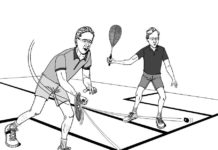By Barry Faguy, WSF Referees and Rules Committee
Unfortunately, many sports contain an element of poor behavior in their practice-and Squash is one of them. You have no doubt seen some officials take an emotional punishing, or have taken one yourself, and that kind of thing tends to discourage one from taking the referee’s seat.
Let’s have a look at three areas where we find incidences of poor behavior:

1: Solely Involving a Player
These situations typically occur when a player is upset with his or her play. We would think that such situations would generate only mild forms of disagreeable conduct—but you’d be surprised. Yes, we often just see a player smacking the racket against a leg or the wall, but there’s no guarantee that you won’t witness the whole gamut of loud blasphemy or profanity, accompanied by thrown or smashed rackets. Court doors have been broken in anger under just such circumstances.
2: Between the Players
Sometimes players have a history of not liking each other; sometimes they don’t need a history because they get to not like each other right there! Here, the range of incidences expands—sometimes perilously. A push can be an innocent thing, because of a change in direction, or simply trying to hurry the opponent out of the way. But, things can escalate toward abuse—taking on an element of danger. The next level up in intensity often sees a player deliberately and aggressively hitting into the opponent. Extra wide stances and big swings are used to deliver a message about staking a claim to one’s space.
3: Between a Player and a Referee
This, of course, is the most common place to see unbecoming behavior, typically because of an interference decision that the player perceives as wrong—thus, unfair. You’ll see a range of dark reactions—most often starting with a funny look, head shaking, loud complaining, mocking tones, rack- et or ball or court abuse, audible or visible obscenities—and going downhill from there.
The player’s view
It’s said that players expect Referees to start perfect…and then get better! A player upset by a decision may be entirely justified; it may indeed have been wrong. Maybe it was unfair. However, those situations are a given in the game. Players are keenly aware that their own play will contain errors—and the sooner they adopt the same attitude about officiating errors (real or perceived), the more likely they are to avoid mental breakdowns in their play during the next rallies. Players who cannot see this, or who cannot let it go, will all-too-often find disintegration.
That said, there is no reason that a player cannot question the rationale for a decision. In fact, the rules allow for explanations. It can all be done quite politely—by both people. The player asks why; the Referee provides a short rationale. That’s it! There should be no abuse of this privilege.
As a player, if you have a complaint, make sure it’s seen to be about the decision—not about the Referee. How you express yourself is crucial. Let common sense be your guide. Personal invective is not a good idea. In online video clips, you’ll see this advice followed by most high-level players if they have a compliant.
The Referee’s approach
There are four formal levels of penalties in the ‘Conduct-on Court’ rule: Conduct Warning, Conduct Stroke, Conduct Game, and Conduct Match. You likely already know that, as a Referee, you can impose any one of them for any offense—generally in an ascending order, but not necessarily.
Prevention
However, it almost goes without saying that it would be better for all if we could prevent scaling that ladder. Prevention of poor behavior can come at its most elemental by avoiding common sources of bad conduct (i.e., the Referee not knowing the rules & guidelines well enough, not appreciating different levels of player ability, and not understanding common conventions of the game. See previous articles on that subject).
Warnings
But, no matter the origin, once unacceptable behavior is apparent, you need to take action. If it’s not too egregious, an informal warning can be very effective in preventing escalation. For example: “Mr. Smith, please refrain from hitting your racket against the wall.” I have, on occasion, in club events when at ground level with the players, quickly opened the door and made such comments in a low voice to the player so as not to turn it into a federal case. Of course, if this attempt to intercept any escalation fails, you can go up the scale to something more formal: “Conduct Warning (or Conduct Stroke) Smith for racket abuse”.
Unfortunately, it’s these hundreds of unacknowledged, lower-level incidents that people witness, followed by what appears to be Referee apathy about it, that contribute so much to the poor image many have of the sport—or of officials. The use of warnings delivers subtle, yet clear, messages to the players that you are watching for such behavior—that you care about player conduct.
Increasing the stakes
If the behavior nonetheless worsens, you have little choice but to impose more severe penalties. Contrary to popular belief, you don’t need to move up a level for another similar offense. Having assessed a Conduct Stroke for racket abuse, you can do the exact same thing the next time it happens. Interestingly, many players (including the pros) believe that subsequent penalties must always be more severe. This myth has contributed a great deal to immediately-improved behavior—so perhaps that’s one misconception that we should let lie?
More advice on using the Conduct rule
• Criticisms: Be careful to distinguish a player’s criticism of the decision and criticism of you as the Referee.
• Derogatory remarks: Be careful not to overreact by assuming that such remarks are directed at you. The player may simply be berating himself or herself.
• Show respect: Answering a reasonable question, rather than imperiously dismissing it, shows respect, and goes a long way to fostering a calm environment.
• Avoid officiousness: You walk a fine line to avoid having three people on that court—and imposing yourself too easily or too aggressively can set fire to a powder keg.
• Speak up: When it’s time to invoke the Conduct rule, do it with authority so that the message is lost on no one.
The rules surrounding conduct require a great deal of wisdom—and detailing precisely what to do, and when, is nigh on impossible. However, a set of guidelines in this regard can be found in the ‘Referees’ section of the WSF web site. Finally, remember the old adage: Good judgement comes from experience, but experience—well, that comes from bad judgement.





